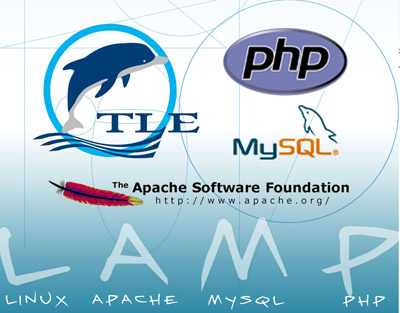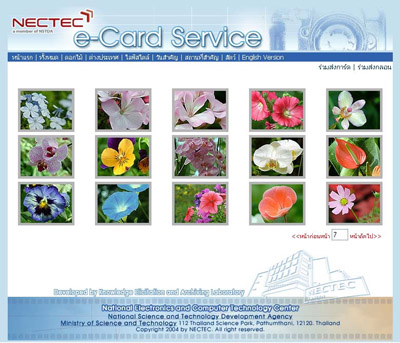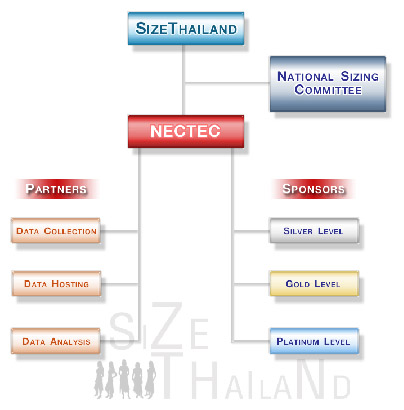There are three major services provided by KEA laboratory – KM Intranet Solution, “LAMP” Training Course, and NECTEC e-card System. Next, details of each service are discussed as follows.
For system development, NECTEC uses open source technology because of its ease of study and of software development and low cost. The technologies used in this open source is called “LAMP” consisting of Linux Operating System, Apache Web Server, MySQL/PostgreSQL, and PHP. KEA/NECTEC also provides training course teaching how to build and operate “LAMP”.
KM Intranet Solution contains ten job functions shown below:
- Affiliation Center: a management center of name cards
- Papers: a management center of research publications
- Meeting: a management center of meeting minutes
- Software: a collection of software components
- Tips & Tricks: a collection of programming tips and tricks
- Presentation: a management center of work presentations
- Budget: a management center of project budgeting
- Inventory: an inventory management of hardwares
- Webboard: an online discuss forum
- Video: a management center of video clips
Notable features of KM Intranet Solution are listed below.
- On-line Service
- Customized metadata
- Open source tools
- Web-based back office
- Ten ready-to-use systems
Next, KEA second service is presented.
2. "LAMP" Training Course
This training course teaches how to build a LAMP server – a system of Linux, Apache, MySQL and PHP –, that is, how to install MySQL and a PHP-enabled Apache Web server on Linux operating system. To build a LAMP server, a series of operations includes how to build and install Apache Web server on Linux OS, how to install and manage database using MySQL, and how to write PHP – a general-purpose scripting language suited in web development – to communicate with users and database system. This web programming software is developed with open source tools.

The training course titled Web-Base Application by Open Sources Tools is taught in four days as a workshop activity. Daily program is presented as follows.
Day 1: Learn how to write PHP codes to create Web to communicate with users
Day 2: Learn how to install and manage Linux Operating System, Apache Web server, and a database management system MySQL
Day 3: Learn how to write PHP codes to communicate with MySQL
Day 4: Develop a “LAMP” server using knowledge learned in previous three days
Focus Group:
- Programmers with experiences in any computer languages.
- Anyone with fundamental knowledge in database management software.
Next, the third service of KEA is presented.
3. NECTEC e-Card System
NECTEC e-Card system is a free service on web site that enables users to send electronics postcards or greeting cards. A sender can select pictures, animated pictures, and/or poem then add its personal messages. One can also set an option to receive a notifying email when a recipient opens e-Card.

NECTEC e-Card service is extended work in data warehouse of digital and animated pictures. The main idea is to utilize a set of digital information as a tool to send well wish or share capture knowledge in pictures to recipients. The e-Card service also provides poem that senders can choose and combine it with their pictorial e-Card. Moreover, users enable to contribute digital and animated pictures and poem to data warehouse. These contributed files will be screened by KEA/NECTEC staff for proper manner before posted on the Web.
Not only does a data warehouse manager operate e-Card service on web site but one also manage data and collect statistics. These job functions are at ease with web-based management tool. The system is built and developed using the well known “LAMP” – Linux, Apache, MySQL, and PHP – under a concept of open source software. Therefore, these open source codes are made available to the general public and can be used without financial charge. This allows managers and users to develop codes incrementally under open source rules and agreements.
Notable features of e-Card service are listed below.
For users,
- Free e-Card service on a web site with unlimited quota.
- Enable to choose single or multiple recipients with a notifying email if a recipient open an e-Card.
- Enable to combine animated digital pictures with poem.
For data warehouse manager,
- Enable to manage digital entities – still and animated pictures and poems – via web-based management tool which does not require high expertise.
- Equip with desired statistics functions and its displays.
- Enable to develop codes by extending existing open source codes.
- Do not require high expertise to install and operate a system.
Focus Group:
NECTEC e-Card is designed to serve general public as a tool to send best wishes or share capture knowledge in pictures to recipients. The service is an outcome of added value to existing digital entities in data warehouse – still and animated digital pictures and poems. This system is user friendly for everyone including a data warehouse manager.
Projects on Going
1. Digital Archive Package Tools Research and Development Project
Digital archive is a technology for a long-term preservation of digital content. There are several significant issues to consider in developing a digital archive: technologies and tools, scope, intellectual property, related standard, and partnership. In building the digital collections, we must make sure that the details represent both robust systems for today and archives for tomorrow. In this project, the outputs will be an answer to the question which means is appropriate to developing tool for creating digital archive that consistence properly to the target group. The tool is also easy to use and follow the same standard for the future information exchange. In the first phase, the project will be focused on developing a package open source tool for creating, managing, and publishing information for applications in history, arts, culture, and ancestor intellectual sectors.
2. Information Management System for the Victims from Disasters
For the past few years, there were many catastrophe around the world. Help and support flow from everywhere. KEA/NECTEC, a team to implement the registration system for the Tsunami in the south of Thailand, year 2004), has been continued to do research and development of the ICT system to manage the post disaster events. In the first phase of the project, donation matching and missing persons tracing systems are implemented.
There is a try to develop an ICT system to collect all donations of each disaster and to implement a matching algorithm between donations and victims requirements in the most suitable way. This proposed system consists of four modules: donations registration module, victims requirements registration module, a matching algorithm, and database management module. In the database preparation process, metadata standard for this matching system must be specified in XML format for exchanging data and information between related organizations' databases. The system is a web-based tool providing services via Internet allowing users and system administrators to access the database from everywhere in the world.
From the past experiences in implementing the missing persons registration system for Tsunami victims, it has been summarized that there is no available ICT missing persons management systems in Thailand. The proposed system for managing the missing ones composes of three modules: missing persons registration module, missing persons tracing algorithm, and the DBMS module. XML is also applied for data and information exchange in this system. The proposed web-based service will be implemented to allow users to access the data of the system from anywhere in the country.
3. 3D Scanning Technology for SizeThailand Project
Given the Thai Government’s selection of Fashion as one of its national priorities, and NECTEC’s mission to deploy state-of-the-art ICT, digital fashion is an ideal topic for KEA/NECTEC to pursue. SizeThailand is a project developed to apply the 3D body scanning together with the statistical data processing to produce Thai sizing standards. We plan to host body data on 12,500 subjects, implemented sophisticated size and shape tools. Provided services will be data hosting, data analysis tools, and customized measurement and shape analysis. With scanned body database, possible applications will be developed such as size recommendation, made to measure garments, and 3D garment try-on visualization. Prof. Philip Treleaven, a founder of SizeUK and an advisor of SizeUSA, is kindly give advises to SizeThailand project. Therefore, digital fashion is an ideal topic for KEA/NECTEC to pursue given the growing strength of the Thailand fashion industry, and the potential for offering digital fashion services via the Internet.

4. Gene Identification for Polygenic Disease Ressearch and Devlopment Project
A polygenic disease means a disorder that is affected by many genes. Most of well known diseases in this class include autoimmune disease, heart disease, diabetes, obesity, autism, cancer and many others.
In the post-genome era, the greatest challenge in the study of human-disease has been the understanding of causes underlying genetic disorders. For many complex disorders as mentioned above, the causes are known to be the defects of multiple genes or along with environmental factors to create a gradient of genetic susceptibility for the diseases. Traditionally, the genes can be tracked by using linkage analysis approach, which tests co-segregation within families of the disease trait through the generation. However, detecting the disease-susceptibility requires the identification and characterization of genes involved in polygenic disorders. This process is a difficult task due to a lot of independently contributing factors and the requirement of substantial resources, including very large collections of family data and highly informative genetic markers spanning the genome.
We are conducting a computational approach to discover such the underlying genetic causes. Our approach utilizes high-throughput data along with the network of protein interactions and metabolic pathway information. This 3-year project aims to develop the efficient methods to elucidate a set of essential genes, which are responsible for a specific polygenic disease and of high medical importance.
5. Web Sites Development for Projects under Initiative of Her Royal Highness Princess Maha Chakri Sirindhorn
The fast innovation and widely use of the Internet have made many organizations realize that how the Internet is important for public communication. As seen in many organizations, they have published their contents on the organization web site. The main problem of publishing information via the Internet is lacking of an easy to use tool for non-technical persons using for manage the contents. For example, the organizations that are working on the project under initiative of Her Royal Highness Princess Maha Chakri Sirindhorn want to publicize their contents via the Internet but they lacked the expertise on web application development. So the development and maintenance of web sites under the initiative of HRH Princess Maha Chakri Sirindhorn project was started by responsible for design and develop web sites, design and develop database system, and develop a web-based management tool. This tool will used by the organization or the project under the initiative of HRH Princess Maha Chakri Sirindhorn for creating, managing and publishing their contents via the internet.

